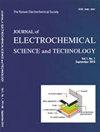Degradation Mechanisms of a Li–S Cell using Commercial Activated Carbon
IF 3
4区 工程技术
Q3 ELECTROCHEMISTRY
Journal of electrochemical science and technology
Pub Date : 2023-09-20
DOI:10.33961/jecst.2023.00451
引用次数: 0
Abstract
In lithium–sulfur (Li–S) batteries, encapsulation of sulfur in activated carbon (AC) materials is a promising strategy for preventing the dissolution of lithium polysulfide into electrolytes and enhancing cycle life, because instead of solid–liquid– solid reactions, quasi-solid-state (QSS) reactions occur in the AC micropores. While a high weight fraction of sulfur in S/ AC composites is essential for achieving a high energy density of Li–S cells, the deterioration mechanisms under such conditions are still unclear. In this study, we report the deterioration mechanisms during charge–discharge cycling when the discharge products overflow from the AC. Analysis using scanning electron microscopy and energy-dispersive X-ray spectrometry confirms that the sulfur in the S/AC composites migrates outside the AC as cycling progresses, and it is barely present in the AC after 20 cycles, which corresponds to the capacity decay of the cell. Impedance analysis clearly shows that the electrical resistance of the S/AC composite and the charge-transfer resistance of QSS reactions significantly increase as a result of sulfur migration. On the other hand, the charge–discharge cycling performance under limited-capacity conditions, where the discharge products are encapsulated inside the AC, is extremely stable. These results reveal the degradation mechanism of a Li–S cell with micro-porous carbon and provide crucial insights into the design of a S/AC composite cathode and its operating conditions needed to achieve stable cycling performance.商用活性炭降解锂电池的机理研究
本文章由计算机程序翻译,如有差异,请以英文原文为准。
求助全文
约1分钟内获得全文
求助全文
来源期刊

Journal of electrochemical science and technology
ELECTROCHEMISTRY-
CiteScore
6.30
自引率
8.10%
发文量
44
期刊介绍:
Covering fields:
- Batteries and Energy Storage
- Biological Electrochemistry
- Corrosion Science and Technology
- Electroanalytical Chemistry and Sensor Technology
- Electrocatalysis
- Electrochemical Capacitors & Supercapcitors
- Electrochemical Engineering
- Electrodeposition and Surface Treatment
- Environmental Science and Technology
- Fuel Cells
- Material Electrochemistry
- Molecular Electrochemistry and Organic Electrochemistry
- Physical Electrochemistry
- Solar Energy Conversion and Photoelectrochemistry
 求助内容:
求助内容: 应助结果提醒方式:
应助结果提醒方式:


